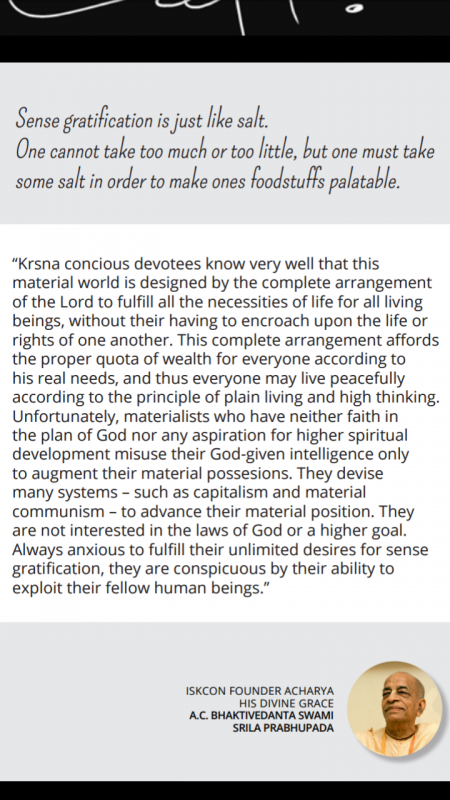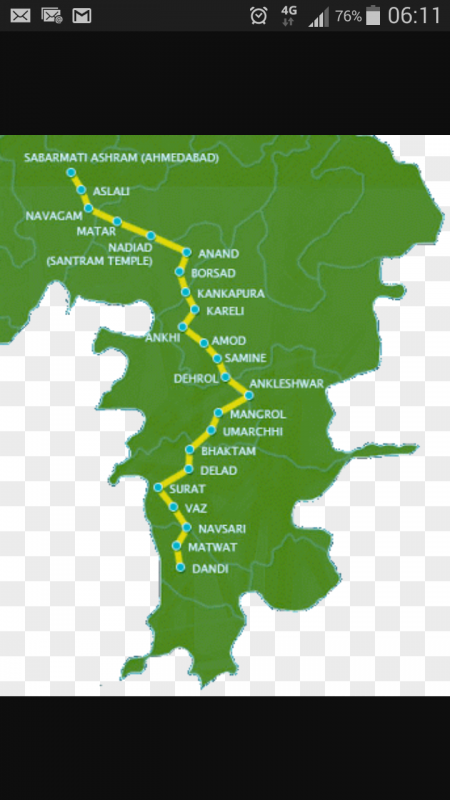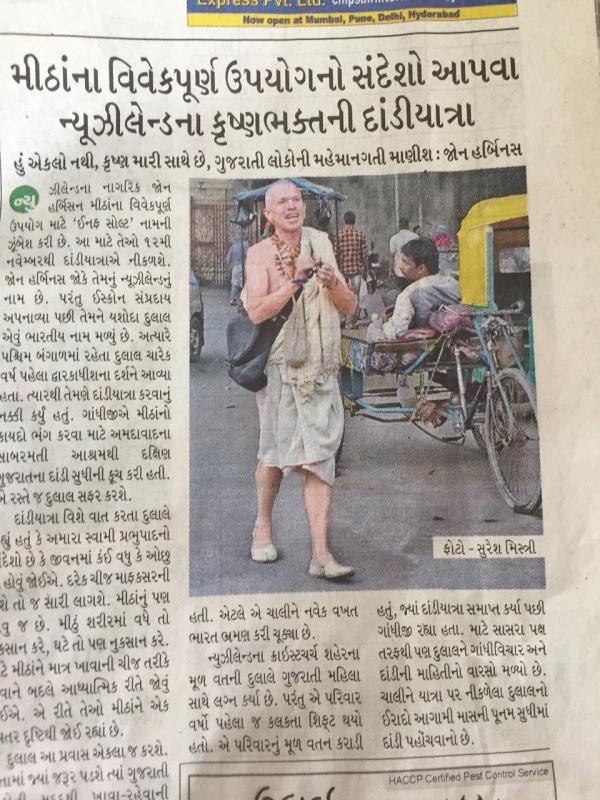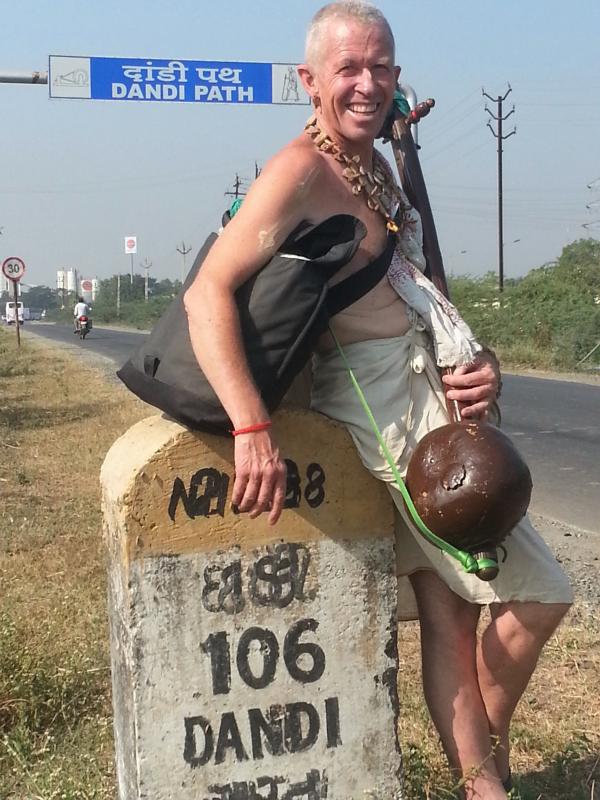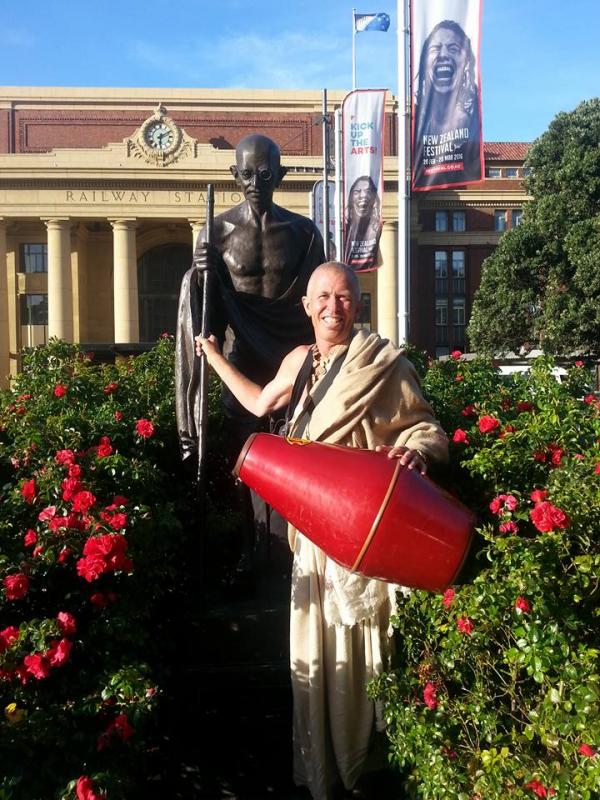by Yasodadulal Dasa
Introduction by Gaurangi Dasi:
Looks like Yasodadulal Dasa is turning into a second Walking Monk, or rather a “Walking Vaisnava” , since he’s still a grhastha. On November 12, 2017, he started his 386 km (=240 miles) solo walk in Gujarat , following in the footsteps of Mahatma Gandhi’s 24 day Dandi March in 1930. He was blessed by these words from his spiritual master, Lokanath Swami : “May Gauranga be with you every step of the way! Go for Gauranga!” Yasodadulal began his padayatra from Sabarmati Ashrama situated on the banks of Sabarmati River, in Ahmedabad and was planning to be on the road for approximately one month.
This event was covered by one of the world’s leading Gujarati newspapers -Gujarat Samachar. In the article Yasodadulal explains how the teachings of Srila Prabhupada and the instructions of his spiritual master, Lokanath Swami Maharaja, have inspired him to undertake many different padayatras, mostly in his native New Zealand, but also in Fiji. This is his second solo walk, the first one being in 2016 in New Zealand, and this Dandi Yatra being his first solo walk in India. It might look like a solo walk, but as Yasodadulal says, “I am not alone. Krishna is with me.”
Why I chose this route?
Yasodadulal: “I chose the route taken by Gandhi because I knew that Indians, especially Gujaratis, would have a fascination with the same question as you have. They already have a sentiment for Gandhiji, as some sort of Mendicant with a Message, so my fascination was to capture that affection that they have for him and take it one step further by adding Krishna.
The history is that Gandhi put India on the world stage with his promotion. ‘I want world sympathy in this battle of Right over Might’, he said. In this way he protested the British imposition of a tax that all Indians would have to pay when purchasing salt that was freely available on their own shorelines. To capture the limelight he began a “Salt March” that left from Sarbarmati Ashram in Ahmedabad and walked 400km south down the coast of Gujarat to reach the town of Dandi. Once there he bent down and picked up a pinch of salt to break the law and defy the British Rule. This act was to demonstrate India’s strength in conducting a nonviolent stance of non co-operation. He started with 75 men and ended up with 50,000, all wearing cotton khadi cloth (handwoven cloth made in India). It became known as the White River as men joined him in ever increasing numbers.
My intention is to catch the wave of already established interest and fascination with this piece of history and give a message with a Krishna Conscious twist. The slogan is: “Enough Salt! Chant Hare Krishna!” This is all explained in a flier he designed and distributed along the way:
Sense gratification is just like salt.
One cannot take too much or too little,
But one must take some salt in order
To make one’s foodstuffs palatable.
This flier includes a quote from Srila Prabhupada explaining how, by the Lord’s arrangement, every living entity gets what they need for their subsistence. (See attached flier)
Unlike Gandhi I began with one man and will probably finish with one man, but my desire is that hundreds of thousands will hear my simple message, or at least read the name of Krishna or ISKCON in the newspaper articles that will be written for the public. Ultimately, just as India generates it own salt, similarly “Mother India” provides also the most nourishing source of spiritual knowledge. She doesn’t have to go outside for that: the Bhagavad-gita and the Srimad-Bhagavatam are the panacea for all the world’s problems. This is also the underlying message portrayed in the pastime of Sudama Vipra and Krishna. By the way, it is also interesting that Sudama also took his birth in the village of Poorbhanda where Gandhi was born.
Krishna Consciousness is freely available to everyone
This Krishna Consciousness is freely available to all people regardless of creed, race, caste or nationality. Bhaktisiddhanta Saraswati Prabhupada informed Abhay Charan that Lord Caitanya’s teachings would go on regardless of whether or not India gained its independence. This point is the extra step that my walk stands for and goes beyond Gandhian thought. Lord Caitanya also established His mission with the simple non -violent method of chanting Hare Krishna. He is thus bringing about his revolution (viplavo) by attracting the masses to support this simple process. This is a most essential ingredient; like salt, as Kali Yuga progresses, we will not be able to live without the chanting of the holy names. As time, place and circumstances demanded Gandhi was pushing for Indian independence, but the fact is that we are rapidly moving towards globalization. We are becoming but one nation so the finishing twist to this padayatra is the following: “Why not establish a dharma that will free not only India, not only the whole world but this whole jagat (material universe)? People can be liberated to a state of maximum independence simply by implementing the chanting of the Hare Krishna maha-mantra.”
The historic march to protest against the salt law began on March 12, 1930 and gained momentum throughout India.
Here are some interesting facts about the historic Dandi March embarked by Mahatma Gandhi:
- Also known as the Salt March and the Salt Satyagraha, the march to freedom was in protest against the steep tax the British levied on salt
- The Satyagraha was an act of nonviolent civil disobedience in colonial India initiated by Gandhi to produce salt from seawater, as it had been practiced by the Indian people until British officials deemed such production illegal and repeatedly used force to stop it
- Because of the British intrusion, the Indians could not independently produce salt and were forced to buy expensive salt
- The 24-day march that began with as many as 8 volunteers swelled to a few thousands as it reached its destination on April 5, 1930
- Growing numbers of Indians joined them along the way as Gandhi and the others continued on what would become a 24-day march to Dandi in order to produce salt without paying the tax
- Gandhi led the Dandi March from his base, Sabarmati Ashram, near the city of Ahmedabad to Dandi, a village near Surat, a distance of 385 kilometres
- The Dandi March had also kick-started Gandhi’s famous Satyagraha Movement.

